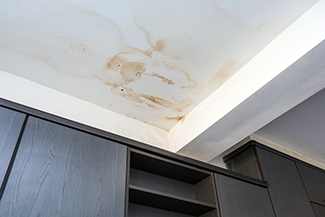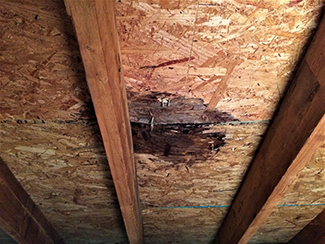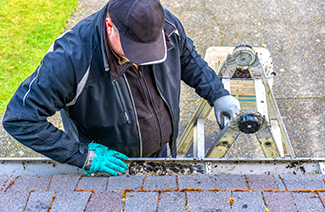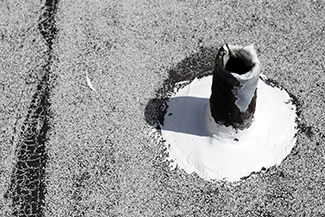Inspect Your Roof For Leaks Before The Rains Arrive
Inspect Your Roof For Leaks Before the Rains Arrive
If you made it through Monsoon 2021 without severe roof damage or leaks, consider yourself lucky. Thousands of Arizona homeowners were not. Because of the unprecedented backlog of calls, many homeowners are still waiting for their roofs to be repaired. February and March historically prove to be our second wet season, let’s get ready now!
But what if you sustained damage and don’t know it? Here are some telltale signs provided by West Coast Roofing, and Lyons Roofing, each a Rosie-Certified Partner, that your roof leaked:

1 | Shoddy Shingles
When a roof starts to leak and absorb water, its shingles may start to bulge, warp, or buckle. If you see roof granules on the ground, you are overdue for an inspection.
2 | Ceiling Spots
When a roof leak becomes severe, you may start to notice water spots on the ceiling. If you find that your ceiling has stains, discolorations, or other signs of water damage, a leaking roof could be the source of the issue.
3 | Mold and Algae
Mold requires moisture and humidity to grow. When your roof starts to leak, you may notice mold growth on the surface of your roofing shingles or throughout your interior spaces.
But what if you don’t see any of that? Does it mean you are in the clear? Nope. There are other places to look for damage.
Hide & Seek
Crawl Spaces and Attics
 Leaks often appear in the attic and garage where you have a storage area above the finished area. Water staining may be visible there and nowhere else. When the roofing system above these areas begins to fail, it's not always obvious because you haven't yet seen any of the interior signs until a significant amount of water has penetrated to the area below.
Leaks often appear in the attic and garage where you have a storage area above the finished area. Water staining may be visible there and nowhere else. When the roofing system above these areas begins to fail, it's not always obvious because you haven't yet seen any of the interior signs until a significant amount of water has penetrated to the area below.
If you can access the space, inspect it with a high-powered flashlight illuminating the beams. Look for water stained, discolored wood. Call a professional roofing company if you cannot access the area or are unsure what you are looking for.
Note: Not every roofing company will crawl into the attic space. Confirm the areas they are willing to access before scheduling the appointment.
Roof Leak Causes & Prevention
Standing Water & Sun
Sun-heated, standing water on flat roofs creates a drainage problem. When water cannot drain off, the saturated roof material can deteriorate and water can enter the structure, causing more damage.
Prevention: Make sure the roof system is watertight and there are adequate drainage routes, no "bird baths” or ponding of water.
Clogged Drainage Routes
 Remove debris such as leaves, branches, dead critters, and bird droppings from your roof, particularly in the valleys where they tend to gather. Debris will prevent the flow of water and decay the roof’s surface.
Remove debris such as leaves, branches, dead critters, and bird droppings from your roof, particularly in the valleys where they tend to gather. Debris will prevent the flow of water and decay the roof’s surface.
Prevention: Have your roof inspected annually to check and empty drains to ensure effective water drainage.
Extreme Weather Fluctuations
Rapid temperature changes can cause the roof to first expand in the heat and contract with the cold. These movements in the roof can cause elements in the roof system to crack, separate, and become loose.
Prevention: On a flat roof, a reflective coating can help minimize the effect of temperature changes by keeping the temperature of the roof more consistent.
Roof Inspection
 If a tile roof is more than 15 years old, the underlayment will need to be inspected by a professional. Lyons Roofing notes that an inspection should include the following:
If a tile roof is more than 15 years old, the underlayment will need to be inspected by a professional. Lyons Roofing notes that an inspection should include the following:
- A check of the roof’s surface for cracked, loose, or slipped tiles. It is important to protect the waterproofing underlayment component of your tile roof system.
- A check of the sealant around all penetrations (pipes, skylights, ductwork, etc.) looking for cracked sealants; repair as needed.
- A check of the home’s perimeter for signs of leaks. Rotted wood fascia and peeling paint is a symptom of a problem, not a problem itself, don't repaint until you are sure.
Anytime you find a leak, call for a free roof inspection. If there are no telltale signs of damage, schedule a visit in the month of May, before the monsoons arrive. You will want that wiggle room in case the roofing company finds an issue. Be sure to schedule your inspection in advance before availability fills up.
Important Note: If your home or roof is fairly new, be sure that any work performed will not void its warranty.
Home Maintenance To-Do | Prevent a #RoofLeak
###
Podcast
If you made it thru the last rain storm with no leaks or haven't had a roof inspection in a long time, Rhonda LaNue of Lyons Roofing discusses the roofing materials and the challenges the companies in the roofing industry are facing. Plus, we discuss how the homeowner can check their own roof and look for possible problems. We also share an important tip on replacing a showerhead and more!
Photo Credit
- Shutterstock
Related Content
- DIY FAQ: My Roof Has Hail Damage. Is It Going To Leak When It Rains?
- Blog: 25 Tips And Tricks To Extend The Life Of Your Roof | Lyons Roofing
- DIY FAQ: Can You Inspect Your Roof Yourself?
- DIY FAQ: Rosie's Roofing Consumer Guide
- Certified Partner: West Coast Roofing
- Certified Partner: Lyons Roofing | Tucson
- Certified Partner: Lyons Roofing | Phoenix
- Certified Partner: Overson Roofing
- Certified Partner: Johnson Roofing
- Certified Partner: Durafoam, Inc.
- Certified Partner: Pinnacle Roofing
